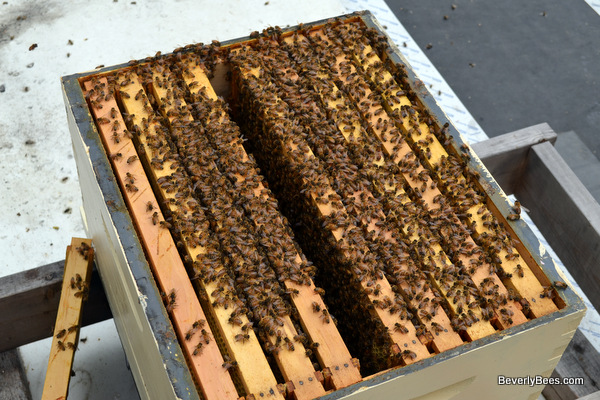Queen Cups With Eggs!
Crocus spent the end of April and beginning of May ditching and evicting drones when they reared new bees faster than they could feed them. Then we were hit with cold rainy weather which prevented the field bees from foraging. I was worried this hive may be starving.
I checked them briefly on 5-13 and they were doing much better. Without any feeding and despite the rain, they had deposited three frames of nectar and some pollen. There were still many empty frames in the bottom super and room for the queen to lay, although the hive was filled to the brim with bees.
On 5-26 I checked them again. Both supers were overflowing with bees. It was hard to manipulate frames without touching bees or smoking them.

The bees were calm and gentle as normal. Despite being mostly empty, the bottom super was just as full of buzzing little bees as the top. Every single frame was absolutely covered in them.

A few bees were carrying red pollen which was interesting to see.

The girls had eaten much of the 3 frames of nectar they had during the previous inspection. There wasn’t any capped honey and only a few frames which were half full of nectar and some pollen. There was not enough food in there for all the bees in this hive. They just didn’t seem to be gathering it as fast as they consumed it.

The queen was laying mostly in the top super and the bottom was filled with 9 empty frames of comb with only one frame in the middle containing some capped brood and queen cups.

Then I spotted it! Staring right at me inside a queen cup and below some drone comb was a white glistening egg. It was still standing upright so I knew it was only a day or two old. A newly deposited egg will slowly lay down until it is resting on the bottom of the cell when it hatches on day 3 to a larvae. Further inspection of the hive revealed another queen cup with a day old egg standing upright in the cell. Despite the lack of food these bees were beginning swarm preparations.

Now I had to make a decision. Do I split this hive to prevent swarming or cut out the queen cups? There were more empty queen cups the bees could use to raise a queen and they could always rebuild the ones I cut out. As a rule, I hate cutting queen cells and try not to do it so I don’t end up queenless by mistake. It’s still a possibility the bees are only trying to replace the queen and not swarm, despite the location of the cups.
I really didn’t want to split this hive but didn’t want swarming bees in my neighbor’s yard either. I decided splitting was the better option. I had to put together more equipment first, since I used my only extra setup for my swarm call the day before. I would wait and split the hive the next day if the eggs had hatched. Hopefully this would give the bees more room and stop their swarming preparations in time.
Read my next post to find out what happened during the split and if I was able to stop the swarm.
